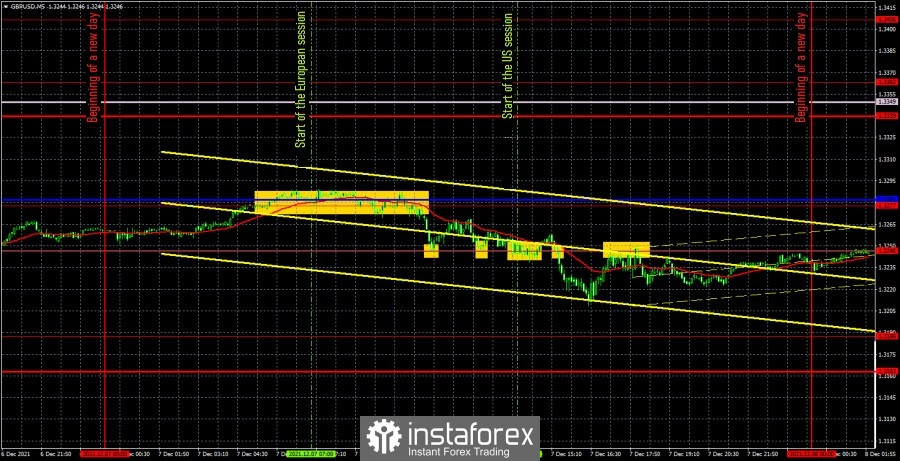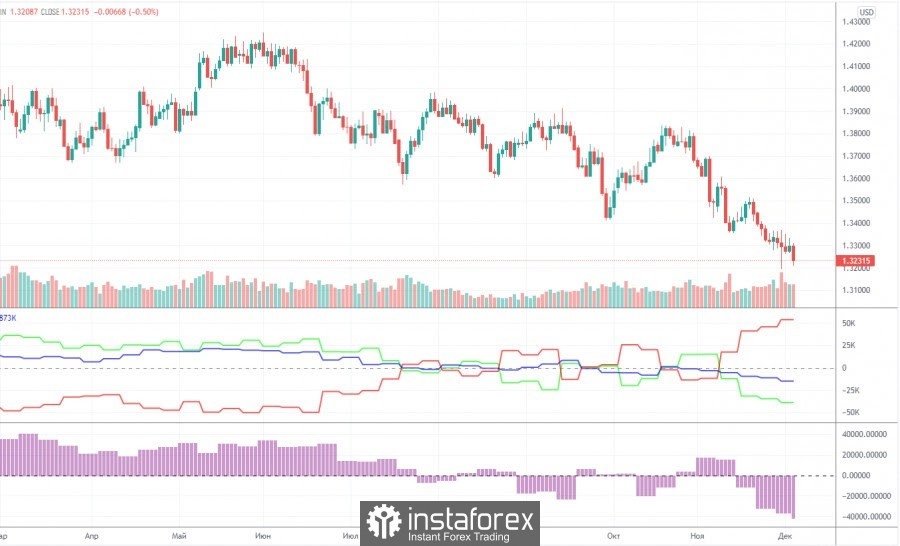GBP/USD 5M

The GBP/USD pair also moved with a downward bias on Tuesday. Thus, both major pairs continue to slide down, that is, the US dollar continues to grow in them. And this is despite the fact that on Monday and Tuesday there were some macroeconomic statistics and there was definitely nothing that could support the dollar. Thus, it looks like the markets are set to buy more US currency anyway. Consequently, the main factor behind the dollar's growth may be the Federal Reserve and it's very likely tightening of monetary policy in December. As for the vital picture of the state of affairs, a fairly large number of trading signals were formed on the pound/dollar pair on Tuesday. However, as is often the case with indistinct movements, most are false. Let's see how the pair should have been traded yesterday. The first sell signal was formed for half a month. The price settled below the critical line and the extreme level of 1.3277, so traders had to open short positions. Then the price reached the level of 1.3246 and bounced off it three times. Thus, short positions should have been closed at about 16 points in profit and long positions should be opened. However, the pair could not go up even 20 points, so Stop Loss could not be set to breakeven. As a result, the trade closed at a loss of about 16 points when the pair settled below 1.3246. At the same moment, new short positions should have been opened. But the price again failed to reach the closest level of 1.3186 and returned to 1.3246. This time, the Stop Loss order was placed, so the deal was closed using it. However, a new sell signal was formed near the level of 1.3246, but it should not have been worked out any more, since at that moment several false signals had already been formed near the level of 1.3246. As a result, Wednesday ended with zero profit.
GBP/USD 1H

On the hourly timeframe, the pound/dollar pair continues its downward movement. Moreover, yesterday it made another attempt to settle above the descending channel, and was again unsuccessful. We also draw your attention to the fact that the pair bounced off the Kijun-sen line and the trend line very imprecisely, as if it had been pondering for a long time about what to do. And at the moment, the annual lows have not yet been updated, therefore, a new attempt to settle above the trend line may follow today. We distinguish the following important levels on December 8: 1.3193, 1.3246, 1.3288, 1.3362, 1.3406. Senkou Span B (1.3321) and Kijun-sen (1.3280) lines can also be signal sources. Signals can be "rebounds" and "breakthroughs" of these levels and lines. It is recommended to set the Stop Loss level at breakeven when the price passes 20 points in the right direction. The Ichimoku indicator lines can move during the day, which should be taken into account when looking for trading signals. There will be no major report, no major event on Wednesday in the UK. It's the same in the United States. Thus, the fundamental and macroeconomic background will simply be absent for the second consecutive day. Consequently, volatility may remain low, although yesterday the pair moved from a low to a high of around 80 points.
We recommend you to familiarize yourself:
Overview of the EUR/USD pair. December 8. The foreign exchange market is still calmly reacting to the new Omicron strain, but the dollar is still growing.
Overview of the GBP/USD pair. December 8. Boris Johnson's political ratings are declining. And this is a problem for the British Premier.
Forecast and trading signals for EUR/USD for December 8. Detailed analysis of the movement of the pair and trade deals.
COT report

The mood of professional traders became a little more bearish during the last reporting week (November 23-29). In principle, quite unexpectedly, the bears became almost twice as strong as the bulls. Recall that since about August, the bulls and bears could not decide who to dominate the market. This is clearly seen by the two indicators in the chart above: the net position of the "non-commercial" group was constantly jumping from side to side. However, in the last few weeks, professional traders have increased the number of shorts to 93,000, and the number of longs has remained at 51,000. Thus, at this time, the mood can really be described as bearish. Consequently, it can be concluded that the pound will continue to fall. However, as always, it does not do without one "but". The red and green lines of the first indicator, which indicate the net positions of commercial and non-commercial traders, the two most important and large groups, have moved quite far from each other. They were at about the same distance in May-June, when the upward trend ended. And a strong distance from each other of these two lines just means that the trend may end. Of course, if the demand for the dollar does not decline, and there is still the same negative fundamental background in the UK, then nothing will prevent the US currency from continuing to grow. However, a further fall in the pound will mean that the number of shorts will continue to grow. And it already exceeds the number of longs by almost twice.
Explanations for the chart:
Support and Resistance Levels are the levels that serve as targets when buying or selling the pair. You can place Take Profit near these levels.
Kijun-sen and Senkou Span B lines are lines of the Ichimoku indicator transferred to the hourly timeframe from the 4-hour one.
Support and resistance areas are areas from which the price has repeatedly rebounded off.
Yellow lines are trend lines, trend channels and any other technical patterns.
Indicator 1 on the COT charts is the size of the net position of each category of traders.
Indicator 2 on the COT charts is the size of the net position for the non-commercial group.















